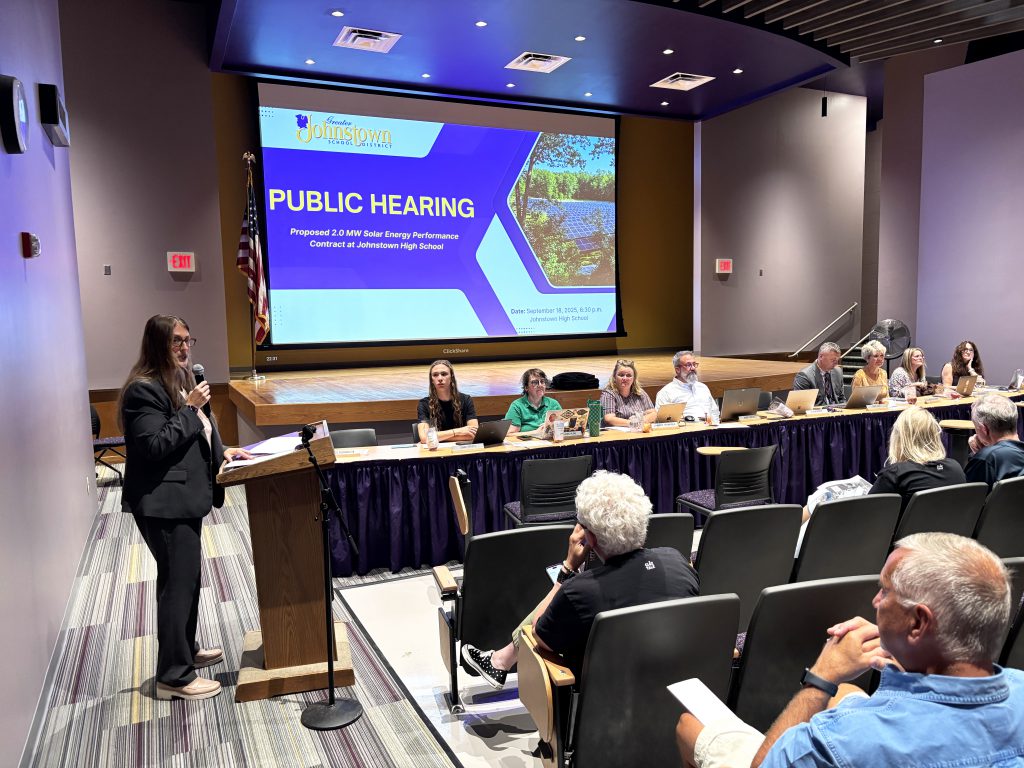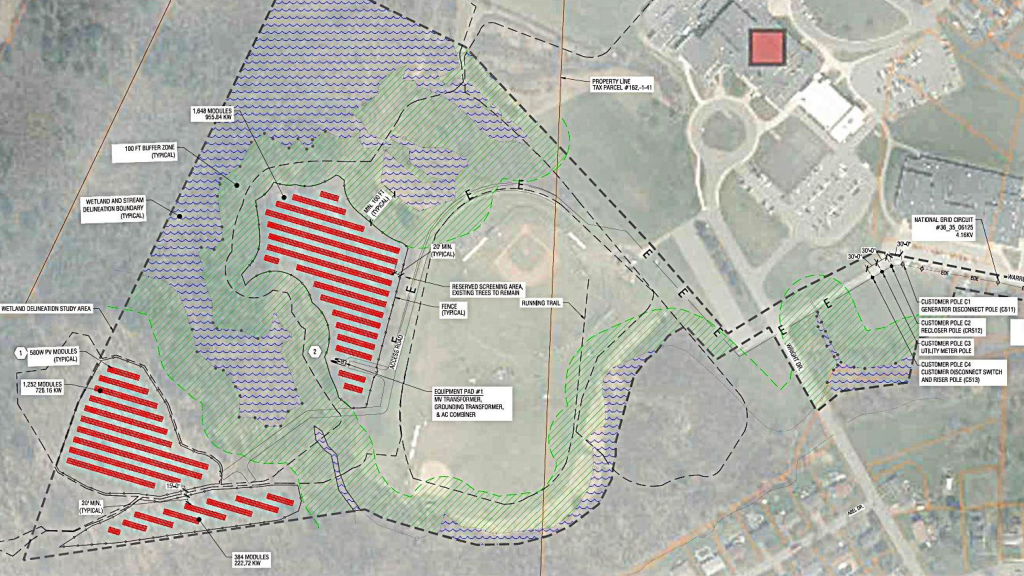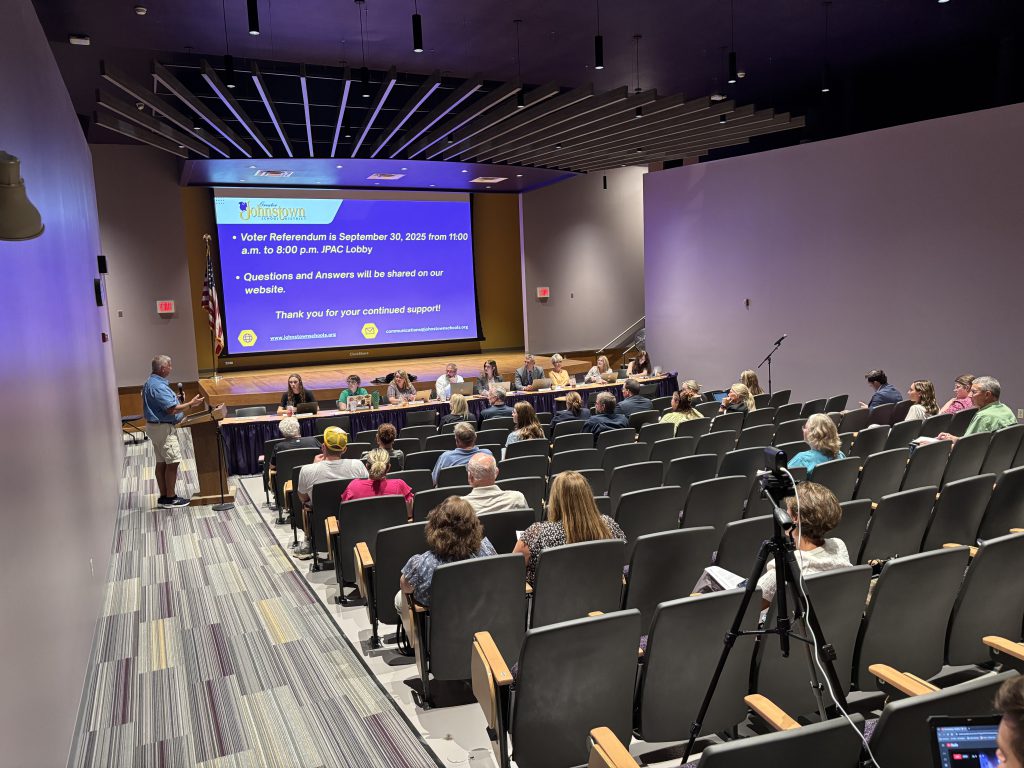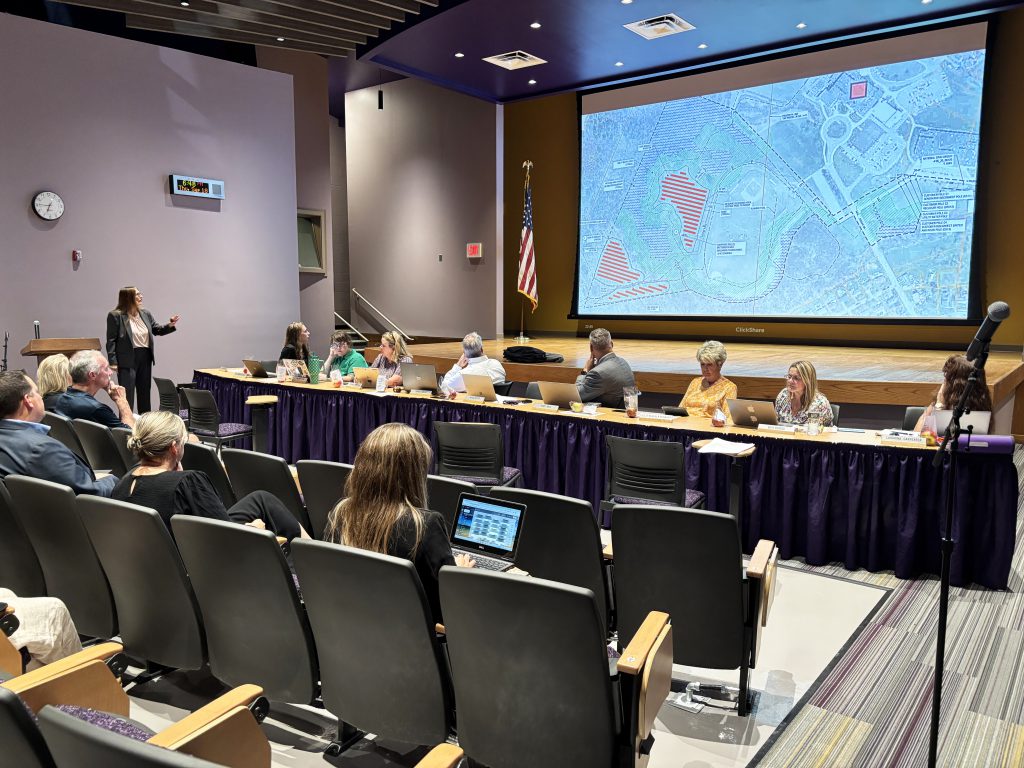
September 30 referendum approval would secure $1.045 million in additional state aid for the project
Approximately 25 community members attended the Greater Johnstown School District’s public hearing on September 18 on its proposed Energy Performance Contract (EPC), which includes the installation of a revenue-generating solar project on District-owned land behind Johnstown High School. The event marked the first public gathering held in the newly renovated Large Group Instruction (LGI) space at the high school.
The referendum will take place on Tuesday, September 30 from 11 a.m. – 8 p.m. in the lobby of the JPAC auditorium at JHS.
At the hearing, Superintendent of Schools Alicia D. Koster delivered a presentation outlining the scope of the project, financial breakdown and the District benefits of the solar initiative. Following the presentation, attendees were invited to share their thoughts and ask questions during a public comment session, with each speaker allotted up to three minutes at the microphone.
Ms. Koster’s presentation is available on the dedicated webpage, or can be viewed here.
The public hearing and Board of Education meeting were livestreamed on the District’s YouTube channel and can be viewed on-demand here:
Part 1: https://www.youtube.com/live/E7OgaGFsPDY?si=_qbEIpGIpY2m5y-G
Part 2: https://www.youtube.com/live/M6MLB2x0HK0?si=GIjmxAj3Wq6_vxne
Reminder that the District has created a dedicated webpage to keep the community informed on the solar project. The webpage can be found here: https://bit.ly/GJSD_EPC_Solar_Overview
If you have questions that are not answered on the webpage, please email communications@johnstownschools.org.

Answers to Questions Raised at the Public Hearing
Partnership with John W. Danforth Company:
The District has selected the John W. Danforth Company—an established firm with over 140 years of experience—as its Energy Service Company (ESCO) for this project. Under New York State regulations, the District is permitted to enter into energy performance contracts for up to 18 years. During this 18-year period, Danforth will be responsible for:
- Guaranteeing annual energy savings. If the agreed-upon energy savings are not met in any given year, Danforth shall reimburse the District for the shortfall by issuing a direct payment
- Maintaining the solar project. Danforth will serve as the primary entity responsible for the ongoing maintenance of the solar energy system.
Specifications of the Solar Project:
The proposed solar energy system is a 2-megawatt array designed to produce approximately 3.2 million kilowatt-hours of electricity per year. This output is expected to cover about 110% of the District’s annual electricity consumption. The 110% figure is important due to New York State Education Department (NYSED) regulations, which cap the amount of energy savings that can be officially reported in an energy performance contract. While the system may generate more than 110% of the District’s needs, only up to 110% can be counted toward NYSED-approved savings.
Potential for Additional NYSED Aid:
Although a community vote is not required for the District to move forward with the project, securing voter approval allows the District to qualify for an additional 10% in aid from the New York State Education Department (NYSED). This increases total state aid from 82% to 92% of the project’s cost—resulting in approximately $1,045,000 in additional revenue.
Location of the Solar Project:
The solar array will be installed on District-owned land located behind the high school, covering approximately nine acres. To maintain the visual appeal of the area, the installation will be screened using existing trees and enhanced with additional shrubbery. The site was carefully evaluated and endorsed by the District’s Shared Decision Making Committee. As stated during both public hearings, the District is committed to fully restoring any soil, grass, or native vegetation that is disturbed during construction.
Why Not Install Solar Panels on the School Roof?:
This option was thoroughly evaluated. However, an architectural assessment found that the high school’s existing roof structure cannot safely support the weight and structural demands of the proposed solar panel system.
Approval Process for the Project:
The solar project has gone through a thorough approval process involving several key agencies including the Department of Environmental Conservation (DEC) and National Grid. As part of this process, a detailed CESIR study was conducted to evaluate geotechnical and other conditions and the project’s connection feasibility to the electrical grid. Currently, the project is approved by National Grid and “in the queue” awaiting NYSED approval to connect the solar array to the grid via a substation on Warren Street.
The District also worked closely with the Town of Johnstown to ensure full compliance with local requirements. It was confirmed that the town’s moratorium on solar development does not apply to this project. In addition, the Johnstown Fire Department has been consulted to address safety considerations in terms of appropriate access to the solar arrays.
The final step in the approval process is review and authorization by the New York State Education Department (NYSED). Construction may begin once NYSED grants its approval.
Why is the Project Exempt from the Local Moratorium?
The Town’s moratorium pertains to panels being installed on leased land to supply electricity beyond the property owner. GJSD’s project is located on District-owned land and would generate electricity for the District’s use. Any business or homeowner in Johnstown also has the right to install solar panels on their own property to meet their individual energy needs.
DEC Approvals & Wetland Protection:
The Department of Environmental Conservation (DEC) is responsible for overseeing wetland delineation studies and ensuring that project designs meet both federal and state wetland regulations. As of January 2025, federal and state oversight on this issue has been consolidated under the DEC.
DEC representatives conducted an extensive, multi-week on-site review of the identified wetland areas. Based on their findings, the project design was adjusted to avoid construction on wetland areas and includes a 100-foot buffer zone between the wetlands and the solar arrays, ensuring protection of the surrounding natural environment.
To meet DEC requirements, the original plan for a single solar array has been modified. The system will now be split into three separate arrays, strategically located to avoid encroaching on protected wetland zones, while remaining a 2-megawatt array.
Cross-Country Trail:
While the majority of the 3.1-mile cross-country trail will remain unaffected, newly released information about the DEC’s required 100-foot buffer zone may result in temporary impacts to small sections of the trail during construction. Any impacted parts of the trail will be restored after construction is complete.The cross-country coach is actively involved in the planning process to help preserve the trail’s integrity—and may even use this opportunity to enhance its level of challenge for student athletes.
Maintenance Plan & Obsolescence Plan:
Maintenance – The John W. Danforth Company is contracted to provide maintenance services for the solar system over an 18-year period. The District also has the option to extend this maintenance agreement to cover the full expected lifespan of the system, which is estimated at 25 to 30 years.
Obsolescence – At the end of the system’s useful life (25 to 30 years), the District will have two primary options:
- Upgrade or replace the system’s components to extend its operation through a new Energy Performance Contract (EPC).
- Remove the solar array entirely.
While it’s impossible to predict future solar technologies, the District anticipates that continuing to maintain, repair, or upgrade the system will be the more likely and cost-effective path—especially given the potential expense associated with full removal, and the continued financial benefits associated with producing its own electricity.
Finances:
The financials of the project are complex, but can be simplified as follows:
- Upfront Cost of Project: The project is capped at $11 million. This is the amount of money that the District must spend upfront to complete the project. The project is 100% self-funded (no cost to taxpayers), thanks to energy savings over 18 years, state aid collected over 15 years and other financial benefits like federal incentives that are collected over time. This project has no additional impact on the levy.
- Energy Savings: Through the District’s contract with Danforth, the solar array must provide ALL of the District’s electricity needs each year for 18 years. The District is expected to save approximately $8.84 million in energy costs over 18 years based on annual costs ranging from $377,000 to $624,000 using a conservative annual inflation factor. If the array fails to provide the guaranteed energy savings, Danforth is contractually obligated to reimburse the District annually.
- Federal Incentives: Federal incentives, yielding as much as $2 to $3 million, are currently available, but will decrease after 2027. Time is of the essence in order for the District to capitalize on federal incentives, before they go away.
- NYSED Aid: Because this is considered a capital project, the District is entitled to receive building aid back on the project over time. Projected state aid over 15 years should result in revenue of $8.62 million (note – this number includes the additional 10% as detailed above).
- The total project at the end of 18 years will provide an estimated net $9.4 million in revenue for the District that can be used to support future budgets.

